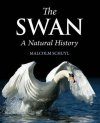"This book ranges widely over a range of subjects relating to swans and their biology, but also to their involvement with humans, including their part in our culture, language, and mythology.
The first chapter deals in a conventional manner with the swans of the world. The next main chapter, ‘Swan biology’, is largely about the functional anatomy of birds. I found the emphasis a little odd for a book about swans, since much of the text describes things which are true for all birds. The statements are not wrong – though they can be a bit vague, for example: ‘Like most birds swans have evolved so that they can fly.’ Many of these statements – and similar ones occur elsewhere in the book – would be fine in a book on birds in general, but seem superfluous in a book specifically about swans, inasmuch as anyone interested enough to read a book on swans would probably have a good idea of this information any way.
Chapter 4, ‘Swan behaviour’, covers most of the subjects one would expect to see here; just over half the chapter takes one through the breeding cycle from pairing to raising the young. There follow chapters on ‘Domestication’, ‘Swan-upping’, ‘Language and the Swan’, ‘Swan and a name or symbol in society’, ‘Swan in culture’, followed by shorter pieces on Law and Conservation.
Overall, it makes for easy reading. Unfortunately, the text contains a significant number of factual errors, such as: ‘for defending themselves, they have developed an enlarged carpal bone halfway along the wing’; ‘experienced birds lay fewer eggs’; ‘they stay together with their parents as a family unit until spring’ (true in only some cases); ‘the darker (orange) the beak, the older the individual… [and the] knob becomes more pronounced with age’; ‘they have been known to dive, but this only occurs when food is difficult to obtain’; ‘Swans will also eat a wide variety of aquatic animals… making them omnivorous’; ‘In 1482… the Act of Swans… limited the ownership of swans to wealthy landowners provided that they kept them on their own land’ (most were kept on rivers, hence the need for the complex system of ownership marks to identify the owner).
If I cannot wax enthusiastic over the text, the same is not true of the photographs. These, for me, are by far the strongest point of this book. Perhaps half the space in the book is given over to colour photographs, including a number of double-page spreads. Mostly these are of mute swans Cygnus olor in action: in flight, swimming and at rest, feeding, courting, breeding, cygnets hatching and growing up, and much else besides. Swans are very photogenic, but their white plumage does not always make for really good photographs such as close-ups of feathers. The photographs here are of uniformly high quality, well reproduced and make for an excellent browse."
- Chris Perrins, www.britishbirds.co.uk, 28-12-2012






































